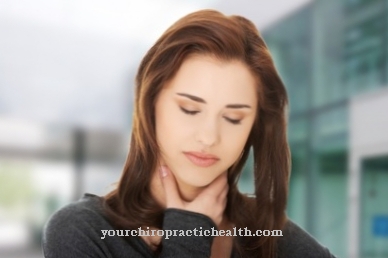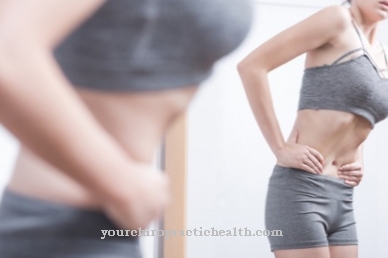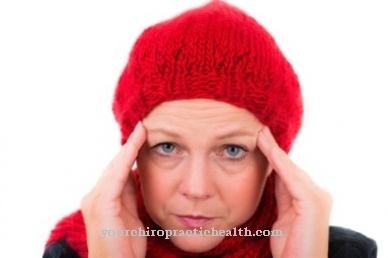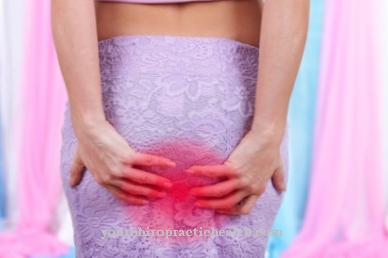Breast tenderness, Aching breasts or Mastodynia is characterized by a feeling of swelling and tightness in the breast area, which in most cases is due to hormonal changes during the female monthly cycle and occurs before menstruation. Breast tenderness and the associated symptoms disappear with the onset of the menopause.
What is breast tenderness?
.jpg)
Breast tenderness or mastodynia is a cycle-dependent sensation of swelling and tension in the breast that usually occurs before menstruation and is often associated with premenstrual syndrome (PMS).
Cyclical breast tenderness is to be distinguished from so-called mastalgia, cycle-independent, rather stabbing and one-sided as well as continuously occurring pain in the chest area, which can also affect men, although the two terms are often used synonymously.
The more frequent cycle-dependent breast tenderness is classified neither as a disease in the strict sense nor as a risk factor for breast cancer (breast tumor), but as a functional disorder that cannot be traced back to an organic impairment.
In contrast to breast tenderness, breast pain that is independent of the cycle can also be caused by organic disorders such as diseases of the heart or changes in the spine.
causes
Cycle-dependent breast tenderness is usually due to hormonal causes, although the underlying mechanisms are not exactly understood.During the menstrual cycle, pregnancy and breastfeeding, the female mammary gland is exposed to hormonal fluctuations that cause the breasts to swell during the second half of the cycle.
An unbalanced estrogen and / or prolactin balance in the second half of the cycle results in water retention (edema) in the breast, which can lead to a feeling of tension or breast tenderness on average one week before menstruation. Accordingly, cyclical breast tenderness is often associated with premenstrual syndrome (PMS).
Cyclical breast tenderness can also be caused or made worse by fibrocystic mastopathy (benign changes in the breast tissue). In some cases, cyclical breast tenderness will also be due to impaired egg cell maturation in the ovaries (corpus luteum insufficiency).
Diseases with this symptom
- Puerperal mastitis
- mastitis
- Mastopathy
- Premenstrual syndrome
- Breast cysts
- Breast cancer
- Pathological secretion of the mammary gland
- Benign breast tumors
- Lipoma
Diagnosis & course
Breast tenderness is diagnosed on the basis of the specific breast complaints and their localization, whereby a pain diary, in which the affected woman records the time, place and severity of the pain, makes sense to differentiate from a cycle-independent breast tenderness.
To determine the underlying causes of breast tenderness, the concentration of the different hormones involved in the female cycle (estrogen, prolactin, gestagens) can be carried out in a blood test. In addition, imaging procedures (mammography, breast sonography) can be used to determine the cause of the breast tension and to differentiate it from mastalgia, which is often due to organic causes such as heart disease, spinal changes, breast cancer, mastitis (breast inflammation) or the use of certain medications (including diuretics, chlorpromazine ) should be used.
Cyclical breast tenderness is usually uncomfortable, but does not lead to any further health consequences. In most cases, cyclical breast tenderness (mastodynia) disappears with the onset of menopause.
Complications
The cycle plays a major role in women. Before menstruation, there is an increase in water retention - an edema - in the breasts. The edema triggers a greater feeling of tension, which is uncomfortable for many women. At the same time, the legs, feet, hands and eyelids can also swell.
The swelling leads to an increase in weight, so that many women feel uncomfortable before menstruation. Sometimes mood swings, nervousness and listlessness can occur during this phase. In a so-called premenstural syndrome, the psychological complaints can seriously affect everyday life. Cyclical breast tenderness is often uncomfortable, but usually harmless. Complications or health consequences are not to be expected. Usually the symptoms disappear at the beginning of the menopause.
Breast tenderness often occurs during pregnancy. When the pain is more severe, women feel restricted in their freedom of movement. Mothers may experience breast tenderness problems while breastfeeding. Particularly in the case of blocked milk, not only can you feel tight, but also redness, inflammation, muscle and limb pain and fever.
Breast tenderness in women during the childbearing period can also be related to what is known as fibrocystic mastopathy. Certain forms of fibrocystic mastopathy can slightly increase the risk of breast cancer.
When should you go to the doctor?
Breast tenderness (mastodynia) is mostly harmless and can be traced back to harmless causes. Breast tenderness often occurs during the female cycle due to hormonal fluctuations and the associated tissue changes and disappears again when the menstrual period occurs.
If this is not the case, a doctor (gynecologist) should be consulted. Men are also subject to hormonal fluctuations that can lead to breast tenderness or pain. Feelings of tension or pain in the chest that appear for the first time that are not cycle-dependent should always be clarified by a doctor. A gynecologist, urologist or andrologist (for men) should be consulted especially if additional symptoms are observed.
These include, in particular, hardening or lumps that can be felt in the breast or armpit, as well as changes that do not occur in both breasts at the same time or lead to a different size in both breasts. A doctor should also be consulted if there is reddened skin on the breast, changes in one or both nipples, or if fluid leaks.
If the breast tenderness is not based on a gynecological or urological cause, the person concerned will be referred to another specialist (e.g. to the cardiologist in the case of a suspected cardiovascular disease) depending on the suspected illness.
Doctors & therapists in your area
Treatment & Therapy
The therapy of a cycle-dependent Chest tension strongly depends on the specific symptoms and the cause of the disease. In some cases, simple techniques such as wearing an adequately fitting brassiere or a healthy and balanced diet can provide sufficient relief, whereby the change in diet includes avoiding caffeine, tea, nicotine, alcohol and excessive consumption of sweets (especially chocolate).
Increasing physical activity is also helpful in some cases. If such measures are not sufficient, hormonal preparations (testosterone-containing agents, anti-oestrogens or prolactin inhibitors) can be used to minimize the disturbed balance in the event of a hormone imbalance. For example, if there is a deficiency in progestogens, especially progesterone, gels containing progesterone are used to apply to the breast.
In some cases, anti-inflammatory pain relievers are also used to relieve pain. If there is fibrocystic mastopathy, which can be accompanied by cyst formation, larger cysts can be punctured to relieve symptoms and thus the pressure within the breast (breast tenderness) can be minimized. In the presence of cycle-independent breast pain (mastalgia), the therapeutic measures are usually aimed at treating the underlying disease.
Outlook & forecast
In most cases, mastodynia does not appear for a long time and goes away relatively quickly. Especially women are affected by mastodynia during menstruation. This leads to tension and swelling of the breasts, which feel relatively uncomfortable. If the swelling does not go away on its own, it should be examined by a doctor.
Sometimes the patients also suffer from mood swings and a lack of drive. Slight irritability can also occur. In many cases, mastodynia is also a sign of pregnancy. However, a clear answer can only be given through a test.
In most cases, the tension will go away on its own and will not be treated. Other bras can also be used to counteract the symptom. Painkillers can be used for severe pain. However, this should not become a permanent problem, as pain killers in high doses are very stressful for the body. Any cysts present are surgically removed. Most often there is a positive course of the disease and the symptom can be alleviated.
prevention
Since the exact underlying mechanisms for cyclic Breast tendernessare not clearly clarified, the complaints can only be prevented to a limited extent. Sports activity, a change in diet without nicotine, caffeine, chocolate and animal fats, as well as a healthy body weight can, however, reduce the extent of the symptoms of breast tenderness.
You can do that yourself
What women can do about breast tenderness themselves depends on the causes and severity of the mastodynia. Often times, even small changes such as not drinking alcohol and cigarettes as well as moderate exercise and wearing a well-fitting bra can bring relief. If breast tenderness occurs during the menstrual period, natural remedies such as lady's coat tea or fenugreek can help. If the breasts not only tighten during menstruation, but also occasionally hurt, over-the-counter pain relievers from the pharmacy will help.
Sore or sore breasts when breastfeeding often make it necessary to adjust the breastfeeding technique. Breast tenderness during pregnancy and breastfeeding should therefore be discussed with the midwife. Tight breasts are also a common side effect during menopause. Women who then do not want to take artificial hormones can try herbal phytoestrogen therapy.
An excess of estrogen can cause uncomfortable swelling of the mammary glands with a feeling of tension, even in men. Men are often embarrassed by this phenomenon. However, since tense breasts can also hide serious diseases, those affected should not be afraid to have the causes clarified quickly by a doctor.



























